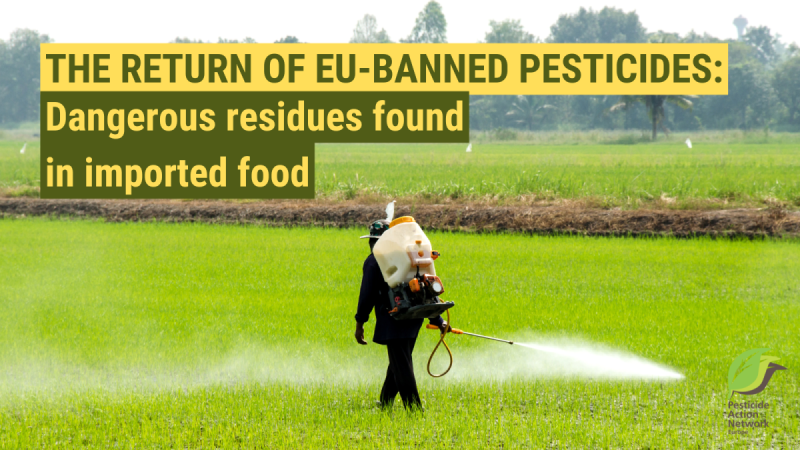The European Commission seems to be rethinking its stance on importing food with pesticides. Recently, the new EU farm chief, Christophe Hansen, recognised that it is unfair to allow food imports from third countries with residues of pesticides banned in Europe. PAN Europe and partners have been warning about this for years.
Our report, Double Standards, Double Risk: Banned Pesticides in Europe’s Food Supply, exposes why it is unfair for European farmers to allow the export of banned pesticides. This enables use in other countries where it endangers farmers, local communities, and ecosystems. It results in imported food containing EU-banned pesticides. Tea, coffee, spices and legumes are more contaminated than other products.
PAN Europe analyzed data collected by the European Food Safety Authority (EFSA) on pesticide residues in food from official control programs of EU Member States. We focused on 48,167 randomly collected plant-based "low-risk" samples, screening them for residues of pesticides banned or severely restricted in the EU and listed in the Prior Informed Consent (PIC) Regulation.
Hazardous pesticides banned in Europe are still produced by European companies and exported to third countries, where safety regulations are often weaker. The use of these toxic pesticides has devastating impacts on both human health and the environment, leading to widespread human rights violations. It also places EU farmers at a competitive disadvantage, highlighting the EU's unethical double standards regarding banned and hazardous pesticides.
Moreover, this report highlights that these dangerous pesticides return to Europe as residues in food. They are found in samples from Member States’ national monitoring programmes not expected to be of any risk. Pesticides such as the mutagenic carbendazim, the reproductive toxin linuron, the fungicide propiconazole, and bee-killing neurotoxic insecticides like thiamethoxam, clothianidin, and imidacloprid continue to be found in plant-based foods sold across Europe, despite their ban. These substances often appear in “pesticide cocktail” mixtures, and in some cases, their levels exceed the established legal residue limits for individual pesticides.
Excessive residues levels detected in food
Maximum Residue Limits (MRLs) for banned pesticides are not automatically lowered to the legally defined minimum (limit of determination: 0.01 mg/kg or lower). Instead, higher allowed residue limits are often maintained to accommodate international trade partners, jeopardizing the health of European citizens.
Key findings of the report
We categorized the products analyzed and discovered that some contain EU-banned pesticides more frequently than others:
- Tea: 38.3%
- Coffee: 22.7%
- Spices: 12.5%
- Legumes: 11.4%
Contamination rates in fruits and vegetables
- European-grown fruits with the highest contamination rates: currants (13.2%), bananas (13.2%), grapefruit (8.8%), and blueberries (8.8%).
- Imported fruits with the highest contamination rates: grapefruit (30.2%), mandarins (26.3%), limes (23.9%), and oranges (13.4%).
- Imported exotic fruits: dragon fruit and passion fruit exceeded legal limits in 5.9% of samples, with many showing multiple residues.
For vegetables, contamination rates were lower:
- EU-grown vegetables: tomatoes (4.3%) and potatoes (6.6%).
- Imported vegetables: peas (20%), beans, and cucumbers (12.5%).
Top exporting countries of food with EU-banned pesticides
- India (23.6%)
- Uganda (17.7%)
- China (16.8%)
- Kenya (16.5%)
- Brazil (16%)
Contamination in a small part of imported organic food
Out of the 48,167 low-risk samples analyzed, 2,181 were organic. Banned pesticides were found in 1.7% of organic samples (36 in total).
Although the numbers are small, the presence of toxic substances in food that is expected to be completely free of such pesticides is concerning. Organic food is only allowed to use substances listed under Regulation 2021/1165, which excludes chemical pesticide formulations. Residues of these pesticides should therefore not be detected at all. This highlights the importance of strict controls.
Contaminated organic categories included:
- Herbs (12.5%)
- Spices (8%)
- Fruits (1.9%)
- Vegetables (1.6%)
- Cereals (1.3%)
Multiple residues were found only in vegetables and cereals. While exposure to toxic chemicals is much lower for organic food consumers, the presence of EU-banned pesticide residues in any food - and especially organic — is entirely unacceptable.
EU needs to act
This report highlights critical contradictions and loopholes in European pesticide legislation. The detection of residues from EU-banned pesticides in food is deeply troubling.
Exporting hazardous pesticides and importing food contaminated with these substances raise significant ethical concerns.
In collaboration with a broad coalition of European and non-European civil society organizations, PAN Europe urges the EU to address these double standards. The export of hazardous pesticides must end, and the import of food containing residues of banned substances should be prohibited. Protecting the health of EU citizens and people in exporting countries and a level playing field for EU farmers must take precedence over trade and industrial profits.
